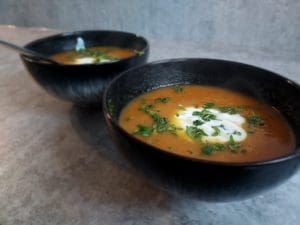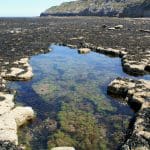As an island nation, we really should make more use of our coastal resources and head out foraging on the marsh. The maximum distance from the coast at any point in the UK is 84 miles, which is the distance from Lichfield in Staffordshire to Wallasey Beach, in the Wirral (72.77 miles as the crow flies). It’s impossible to give an exact figure for the length of the UK coast because of its wiggliness – the more wiggles you measure the longer it gets. Sensible estimates range between 11,023 Km (about 6,850 miles) and 19,717 Km (12,251 miles). Whatever the length, we have a lot of coast, full to the brim of tasty treats to tantalise the taste buds.
When we think about the coast we often think of sunbathing on warm sandy beaches, relaxing to the soothing sound of waves breaking on the shore, hiking along crunchy, shingle beaches, or exploring craggy rock pools at the feet of majestic cliffs in search of mini beasts.
Less often do we think of saltmarshes – perhaps because there is often a wide expanse of apparently inhospitable landscape to cross before reaching the sea.
Although greatly reduced in area, due to being drained to provide more productive agricultural land or to build on as our towns and cities have expanded, marshland still represents 24% of the English coastline, 11% of the Welsh Coastline and 3% of the Scottish coast.
Whilst edible plant species in other coastal habitats are found close to the sea – in sand dunes, on cliff faces and between rocks, but away from the ebb and flow of the tides, which would wash away any soil that can form – saltmarsh is covered in a luxuriously dense mix of species, creating an almost unbroken swathe of vegetation which blankets the muddy substrate. It’s a tricky terrain to traverse so not visited by many people. This makes it a rare opportunity to get away from the hustle and bustle and appreciate the calm, unspoiled serenity of nature. Perhaps also to contemplate the network of deep creaks which riddle the saltmarsh and the dense vegetation, which together provide an efficient buffer to protect the coastline from the erosive and destructive strength of incoming tides and storms.
It’s always a surprise to see the saltmarsh at different stages of the tide. One day you might arrive to see the whole marsh completely flooded; a broad, flat expanse of water, mirroring the sky, with almost no sign of vegetation at all.

A few days later, arriving at the same time of day, it all looks totally dry, almost like heathland. Clumps of greys and greens defining the edges of the creeks, with deeper greens, subtle reds and purples nestled between.
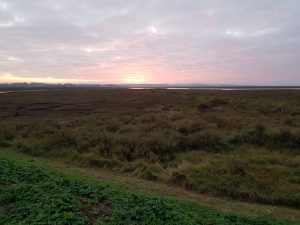
Not such a surprise if you monitor the tidal cycles and phases of the moon but I like a surprise so only check those when I need to.
Tides when foraging on the marsh
If you’re going foraging you really do need to check the tide times and it is also helpful to check the phase of the moon as that dictates how high and low the tides will be. If you’re after Marsh Samphire or Sea Aster, you want to get out to the marsh a bit before low tide and set an alarm to go off at low tide. The alarm is to remind you that you should start thinking about heading back inland. High tide will be about six hours later but the tide comes in pretty quick and fills up the creeks first, so if you’ve crossed any dry creeks on your way out they won’t stay dry for long after low tide and may be too wide to jump across as they fill up.
Lets take a look at what we can find when Foraging on the Marsh
Samphire
Samphire is a traditional, seasonal (May to July) treat in many coastal regions of the UK. You can eat it raw, straight from the marsh but it is nice simmered in a little water for about 15 minutes and eaten with melted butter or sometimes vinegar. It is the pioneer species of the saltmarsh and thrives in fresh mud, where nothing else has started to grow – right out where the marsh meets the sea, 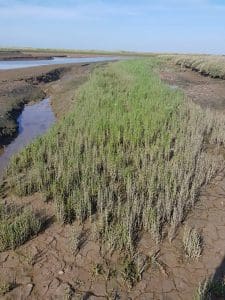 but also on ridges of mud within the muddy creeks, which wind their way through the marsh. Samphire’s roots help stabilise the mud and at the end of the season the plants die back and decompose, adding nutrients to develop a soil in which later successional species can become established.
but also on ridges of mud within the muddy creeks, which wind their way through the marsh. Samphire’s roots help stabilise the mud and at the end of the season the plants die back and decompose, adding nutrients to develop a soil in which later successional species can become established.
Because the mud which samphire grows in is not yet stabilised by a network of roots, it has a loose, almost watery consistency and its depth varies unpredictably. While traversing a creek you may find the substrate quite firm at first but another step can take you way-over-your-wellies in mud. It is a good idea to take a long stick or staff which you can use to test the depth of the mud as you go along.
Sea Aster
The next species in the saltmarsh succession is Sea Aster – our only native Michaelmas Daisy, named because they flower around Michaelmas Day, on 29th September. The flowering stems grow 50cm to a metre tall and have a spray of yellow centred flowers with delicate, pale blue petals, which are easily blown away by the wind. The flowers are not particularly tasty but the leaves are succulent and firm, with a lovely nutty, iron-rich flavour and, like all salt marsh species, a good twist of salt. Again, they can be eaten raw, straight from the marsh but often need a good scrub to get rid of the mud.
 The basal leaves grow in a rosette and can reach up to 50 cm long and 5cm wide but more often only reach 20 to 30cm long. They provide a substantial vegetable accompaniment to any meal, cooked gently with a nob of butter and a splash of lemon.
The basal leaves grow in a rosette and can reach up to 50 cm long and 5cm wide but more often only reach 20 to 30cm long. They provide a substantial vegetable accompaniment to any meal, cooked gently with a nob of butter and a splash of lemon.
Shrubby Sea Blite/Sea Rosemary
So many saltmarsh plants are edible – it’s like an enormous plateful of nutritious vegetables, just sitting there waiting to be eaten. At the high tide mark, the marsh is often bordered by Shrubby Sea Blite which, from a distance, could be mistaken for a gorse bush.

Closer up you can see that the leaves are not sharp and spiky like gorse but are short (1 – 2cm) and cylindrical like short pine needles.
 The branches seem to tangle together to form an impenetrable barrier to the marsh. Have a nibble of the leaves on the top 10cm tips of the branches. They are said to be evergreen but the new growth in spring and through the summer is the most succulent; they’re salty with a slight, woody bitterness. The leaves can easily be stripped from the stem by pinching it with your forefingers and thumb and dragging them down the last 10cm to the tip to collect sprinkles to add to salads or cooked dishes.
The branches seem to tangle together to form an impenetrable barrier to the marsh. Have a nibble of the leaves on the top 10cm tips of the branches. They are said to be evergreen but the new growth in spring and through the summer is the most succulent; they’re salty with a slight, woody bitterness. The leaves can easily be stripped from the stem by pinching it with your forefingers and thumb and dragging them down the last 10cm to the tip to collect sprinkles to add to salads or cooked dishes.
Sea Purslane
Beyond the barrier of Shrubby Sea Blite, the vegetation is lower-growing. The silvery-green Sea Purslane grows up to a-bit-over-knee-high and is often the most abundant species on the marsh. With its twisting wiry stems, it forms dense, springy carpets at all ranges of the tidal reach.
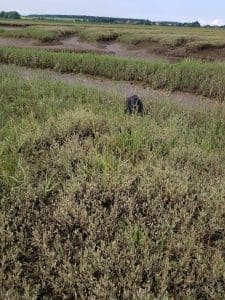
Sea Purslane is quite happy being fully submerged by the sea twice a day but it prefers higher ground where the tide drains away easily. It gains a foothold along the edges of the deep creeks which weave their way through the marsh and gradually raises the level of the marsh by trapping sediments in its wiry stems. As a result, the marsh is also helping in the fight against global warming and sea level rise by locking the carbon in tide-born sediment into the mud. As the surface level rises the land becomes more freely draining, creating conditions preferred by the Sea Purslane, so it gradually forms larger patches, spreading away from the creeks.

Sea Purslane is another one of my favourites. It’s a bit fiddly picking the small (3 – 4cm long) flat, elliptical, grey-green leaves from the stem but, as foragers we don’t expect to just open a packet!
They make a lovely crunchy snack, as an alternative to crisps or peanuts and can be sprinkled on soups or salads, or added to a pasta or risotto. When cooked they become a more vibrant green, add a lovely, salty crunch and are a great source of Omega 3.
In patches of marsh between creeks, where Sea Purslane hasn’t reached, species such as Annual Sea Blite, Sea Arrowgrass, Sea Plantain and Sea Lavender grow in mixed swards.
Annual Sea Blite/Sea Rosemary

Annual Sea Blite is closely related to Shrubby Sea Blite but is much smaller. Their tender, branched stems only reach about 30cm tall, with the half cylindrical leaves alternating up the stem, starting slightly greyish green and becoming reddish/purplish from late summer. I find the texture and flavour very similar to samphire. Both can be used as a base to a dish in place of rice or pasta, after trimming away the woody parts of the stem, which increase in length as both species age.
Sea Arrowgrass
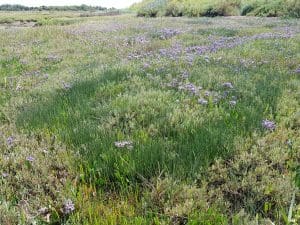 Sea Arrowgrass, sometimes called Sea Coriander, is a great one to give to an unsuspecting friend and ask them what it tastes of. The instant recognition of something they love or hate, followed by puzzlement as they try to pinpoint what the flavour is, reflects the randomness of such a strong, familiar flavour emanating from what looks just like grass. The blades are semi-cylindrical and grow 10-30cm tall becoming larger or more bulbous and lighter in colour towards the base.
Sea Arrowgrass, sometimes called Sea Coriander, is a great one to give to an unsuspecting friend and ask them what it tastes of. The instant recognition of something they love or hate, followed by puzzlement as they try to pinpoint what the flavour is, reflects the randomness of such a strong, familiar flavour emanating from what looks just like grass. The blades are semi-cylindrical and grow 10-30cm tall becoming larger or more bulbous and lighter in colour towards the base.
 It often grows in clumps or rings and can also be found fringing the edges of shallow pools in the marsh. The way I recognise it is by looking for several blades held together at the base in a pale flat sheath. The paler base is the best part to eat so cut it as low to the ground as possible and use it whenever Coriander is called for. Sea Arrowgrass does contain very small amounts of hydrocyanic acid in the greener part of the leaves so use sparingly.
It often grows in clumps or rings and can also be found fringing the edges of shallow pools in the marsh. The way I recognise it is by looking for several blades held together at the base in a pale flat sheath. The paler base is the best part to eat so cut it as low to the ground as possible and use it whenever Coriander is called for. Sea Arrowgrass does contain very small amounts of hydrocyanic acid in the greener part of the leaves so use sparingly.
Sea Plantain
Sea Plantain has the characteristic 3 – 5 veins running parallel up the leaves, as seen in other plantain species. Sea Plantain leaves are narrower and more succulent than Ribwort Plantain. They have a slightly waxy coating on their surface and are sickle-shaped in cross-section. They can be eaten all year round but are best in May/June, after which they become a bit stringy. As well as saltiness, they have a sweetness and a hint of mushroom – as with other plantain species.
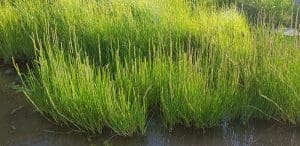
Sea Lavender
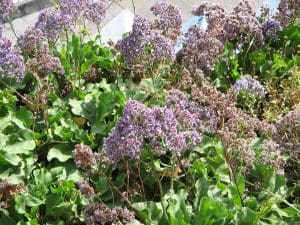
The leaves of Sea Lavender look similar to those of Sea Aster but they are much less succulent and more papery in texture. The leaves don’t grow as large as the Sea Aster leaves, only reaching about 10-15cm. The flowers have a lavender-like appearance, being clusters of pretty, mauve flowers at the top of long, stiff stems. As well as a less succulent texture, the flavour of Sea Lavender leaves is usually described as less pleasant than Sea Aster, with a kind of fishy aftertaste.
However, I have seen recipes on the internet using Sea Lavender as an ingredient.
Not to encourage too many visitors and disrupt the tranquillity of the saltmarsh but, next time you feel like a breath of sea air I would recommend a visit to a saltmarsh; if only to sample the delicious wild produce available. They are a valuable and unique habitat for many species of birds, mammals and insects and only a short flight for a crow from many parts of the UK. The succulent crunchiness of saltmarsh plants make them ideal for a stir fry or try the Carrot and Sea Arrowgrass soup, which really makes the most of the coriander flavour:
Lets take a look at a recipe for after we’ve been foraging on the marsh
Sea Arrowgrass soup
Ingredients
- 500ml good vegetable stock
- 3 large carrots – diced up small
- 1 white onion – chopped and peeled
- The bottom half of 20 stems of Sea Arrowgrass – chopped up (regular corriander works too)
- Alexander Seed & dried seaweed (or a pinch of salt and pepper)
- A spoonful of greek yoghurt
Method for making Carrot and Sea Arrowgrass Soup
- Bring your stock up to a rolling simmer
- Drop in the carrots and onion and cook for about 10 minutes – until the carrots have started to soften, this is dependent on how small you’ve chopped them up.
- Chuck in half the sea coriander ( use a stick blender to blend the lot up)
- Pour in to 2 bowls, chuck a scoop of greek yoghurt in, sprinkle of seasoning and top with the remaining chopped Sea Arrowgrass.
Enjoy with a good chunky of well-buttered bread.
